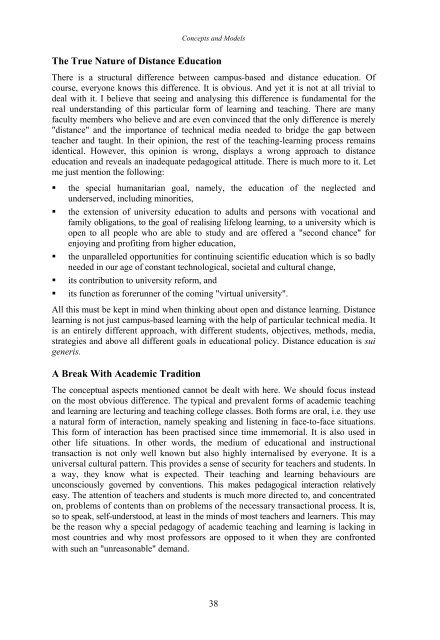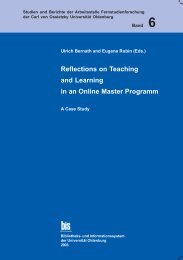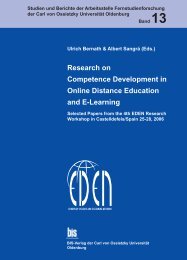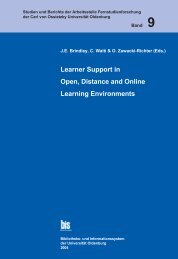Distance Education in Transition - Master of Distance Education ...
Distance Education in Transition - Master of Distance Education ...
Distance Education in Transition - Master of Distance Education ...
You also want an ePaper? Increase the reach of your titles
YUMPU automatically turns print PDFs into web optimized ePapers that Google loves.
Concepts and Models<br />
The True Nature <strong>of</strong> <strong>Distance</strong> <strong>Education</strong><br />
There is a structural difference between campus-based and distance education. Of<br />
course, everyone knows this difference. It is obvious. And yet it is not at all trivial to<br />
deal with it. I believe that see<strong>in</strong>g and analys<strong>in</strong>g this difference is fundamental for the<br />
real understand<strong>in</strong>g <strong>of</strong> this particular form <strong>of</strong> learn<strong>in</strong>g and teach<strong>in</strong>g. There are many<br />
faculty members who believe and are even conv<strong>in</strong>ced that the only difference is merely<br />
"distance" and the importance <strong>of</strong> technical media needed to bridge the gap between<br />
teacher and taught. In their op<strong>in</strong>ion, the rest <strong>of</strong> the teach<strong>in</strong>g-learn<strong>in</strong>g process rema<strong>in</strong>s<br />
identical. However, this op<strong>in</strong>ion is wrong, displays a wrong approach to distance<br />
education and reveals an <strong>in</strong>adequate pedagogical attitude. There is much more to it. Let<br />
me just mention the follow<strong>in</strong>g:<br />
� the special humanitarian goal, namely, the education <strong>of</strong> the neglected and<br />
underserved, <strong>in</strong>clud<strong>in</strong>g m<strong>in</strong>orities,<br />
� the extension <strong>of</strong> university education to adults and persons with vocational and<br />
family obligations, to the goal <strong>of</strong> realis<strong>in</strong>g lifelong learn<strong>in</strong>g, to a university which is<br />
open to all people who are able to study and are <strong>of</strong>fered a "second chance" for<br />
enjoy<strong>in</strong>g and pr<strong>of</strong>it<strong>in</strong>g from higher education,<br />
� the unparalleled opportunities for cont<strong>in</strong>u<strong>in</strong>g scientific education which is so badly<br />
needed <strong>in</strong> our age <strong>of</strong> constant technological, societal and cultural change,<br />
� its contribution to university reform, and<br />
� its function as forerunner <strong>of</strong> the com<strong>in</strong>g "virtual university".<br />
All this must be kept <strong>in</strong> m<strong>in</strong>d when th<strong>in</strong>k<strong>in</strong>g about open and distance learn<strong>in</strong>g. <strong>Distance</strong><br />
learn<strong>in</strong>g is not just campus-based learn<strong>in</strong>g with the help <strong>of</strong> particular technical media. It<br />
is an entirely different approach, with different students, objectives, methods, media,<br />
strategies and above all different goals <strong>in</strong> educational policy. <strong>Distance</strong> education is sui<br />
generis.<br />
A Break With Academic Tradition<br />
The conceptual aspects mentioned cannot be dealt with here. We should focus <strong>in</strong>stead<br />
on the most obvious difference. The typical and prevalent forms <strong>of</strong> academic teach<strong>in</strong>g<br />
and learn<strong>in</strong>g are lectur<strong>in</strong>g and teach<strong>in</strong>g college classes. Both forms are oral, i.e. they use<br />
a natural form <strong>of</strong> <strong>in</strong>teraction, namely speak<strong>in</strong>g and listen<strong>in</strong>g <strong>in</strong> face-to-face situations.<br />
This form <strong>of</strong> <strong>in</strong>teraction has been practised s<strong>in</strong>ce time immemorial. It is also used <strong>in</strong><br />
other life situations. In other words, the medium <strong>of</strong> educational and <strong>in</strong>structional<br />
transaction is not only well known but also highly <strong>in</strong>ternalised by everyone. It is a<br />
universal cultural pattern. This provides a sense <strong>of</strong> security for teachers and students. In<br />
a way, they know what is expected. Their teach<strong>in</strong>g and learn<strong>in</strong>g behaviours are<br />
unconsciously governed by conventions. This makes pedagogical <strong>in</strong>teraction relatively<br />
easy. The attention <strong>of</strong> teachers and students is much more directed to, and concentrated<br />
on, problems <strong>of</strong> contents than on problems <strong>of</strong> the necessary transactional process. It is,<br />
so to speak, self-understood, at least <strong>in</strong> the m<strong>in</strong>ds <strong>of</strong> most teachers and learners. This may<br />
be the reason why a special pedagogy <strong>of</strong> academic teach<strong>in</strong>g and learn<strong>in</strong>g is lack<strong>in</strong>g <strong>in</strong><br />
most countries and why most pr<strong>of</strong>essors are opposed to it when they are confronted<br />
with such an "unreasonable" demand.<br />
38





